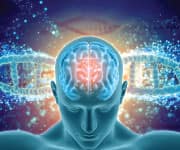Life Extension Magazine®
Neuroscientists at the Johns Hopkins University School of Medicine teamed up with researchers at the National Institute on Aging to identify core mechanisms that contribute to Alzheimer’s disease development.
Their findings, just published in the Proceedings of the National Academy of Science, show that supplementation with the NAD+ precursor nicotinamide riboside improved cognitive function in a mouse model closely resembling Alzheimer’s.1
Nicotinamide riboside achieved these impressive results by restoring brain plasticity. This is how neurons learn and store memory.1
The mechanisms revealed by this study break new ground in understanding relationships between cell energy utilization and DNA repair mechanisms.
Boosting NAD+ was shown to beneficially alter some of the pathological processes that contribute to brain-cell death in Alzheimer’s disease.
The new data demonstrate how an oral supplement proven to increase NAD+ can protect brain structure and function against the scourges of Alzheimer’s.
What you need to know
- New findings in mice show that increasing NAD+ can restore learning, memory, and cognitive functions by boosting cellular energy capabilities and protecting DNA repair mechanisms.
- Mice treated with NAD+ precursors perform better on an entire battery of cognitive tests, and show sharply reduced levels of brain cell-destroying pTau proteins.
Normalizing Alzheimer’s Brain Features

To launch this study, Johns Hopkins researchers first developed a new model of Alzheimer’s disease in mice.1
The mice were genetically modified in ways that impaired their brain cells’ ability to repair DNA, leaving the cells susceptible to developing a toxic form of protein (pTau).1
PTau accumulation produces dysfunctional “tangles” of cell fragments. This caused the animals to exhibit the major features of Alzheimer’s as seen in humans. These pathologies include dysfunction of nerve cell synaptic connections, brain-cell death, and cognitive impairment.1-4
The scientists were exploring the ways that the DNA repair mechanisms in the mice became disabled as a first step in finding a way to overcome the deficit.
They found that the Alzheimer’s mice had reduced amounts of NAD+ in their brains.1
Critical Roles of NAD+
NAD+ is a coenzyme critical for multiple cellular processes, including mitochondrial health, stem cell self-renewal, and brain-cell stress resistance.1,5
NAD+ is required for cells to obtain energy from food, and NAD+ depletion has been observed in aging brains.1,6
As NAD+ levels decline, brain cells lose a critical DNA repair function that appears to inflict Alzheimer’s-like pathologies.1
These findings provide new insight into how Alzheimer’s damages brain cells and how DNA repair can be facilitated.
The Latest Discovery
This new study helps confirm that the energy crisis and DNA repair deficits that characterize brain aging can be resolved by supplementing mice with nicotinamide riboside, a precursor compound that the body rapidly turns into NAD+.1
Not only did the supplement quickly restore NAD+ levels in the Alzheimer’s animals’ brains, it also significantly improved their performance on a wide battery of learning and memory tasks.1
While unsupplemented Alzheimer’s-like mice showed a host of learning and memory deficits, especially in spatial tasks, supplemented mice quickly overcame those deficits, returning to correct locations, identifying new ones, recognizing objects, and finding their way through mazes with as much ease as normal, healthy mice.1
Like human Alzheimer’s patients, the unsupplemented Alzheimer’s mice had gait problems and poor grip strength, but supplementation with nicotinamide riboside ameliorated those difficulties, while also decreasing anxiety-like behaviors similar to those in human subjects.1
Examination of the animals’ brains revealed that boosting NAD+ restored neuronal plasticity to cells in the brain’s main memory bank, the hippocampus.1
Plasticity is the physical cellular event that underlies learning—brain cells must be capable of rapidly changing the number and strength of their connections in order to properly store, retrieve, and augment memories.7
Loss of plasticity is a feature of aging and contributes to the observed memory impediments we face as we age, while restoration of plasticity means that we can continue to use our memories in a youthful fashion.1
How it Works
NAD+ has multiple targets and acts by multiple mechanisms to achieve its effects. This is distinctly different from pharmaceuticals, which are usually designed for a single or at most a few narrow targets.
Here are the specific findings that suggest how boosting NAD+ improved functioning in brain cells of Alzheimer’s mice in this study, backed up by existing research:1
- NAD+ decreases brain-cell DNA damage and premature cellular death by activating powerful sirtuins, which have multiple anti-aging functions, including promoting DNA repair. Sirtuins consume NAD+, while nicotinamide riboside supplementation restored cellular NAD+ levels, permitting the repair mechanisms to operate uninhibited.
- NAD+ increased new brain-cell formation crucial to learning and memory, while reducing inflammatory changes that accompany (and probably contribute to) Alzheimer’s disease.
- NAD+ decreased formation and accumulation of neurotoxic pTau proteins, which are associated with neuronal dysfunction in Alzheimer’s and other neurodegenerative diseases.
- NAD+ relieves mitochondrial stresses associated with reduced DNA damage repair, permitting those energy-generating organelles to perform at more youthful levels.
Previous studies have identified still other ways that boosting NAD+ supports brain health and defeats the impacts of aging.
Research shows that NAD+ also sensitizes cells to insulin,8 reducing the impact of type II diabetes, which itself is associated with cognitive decline.9
In another mouse model of Alzheimer’s disease, boosting NAD+ raised levels of the regulatory complex PGC-1-alpha. Low levels of PGC-1-alpha have been associated with increased beta-amyloid deposition.10
In addition, boosting NAD+ was shown to protect cells against excitotoxicity, a process in which nerve cells become damaged by overstimulation—a known contributor to many neurodegenerative diseases.11
This effect has proven useful in a study of noise-induced hearing loss, in which mice treated with an oral NAD+ precursor had less hearing loss and more intact nerve cells in their cochlea (where sound waves are converted into brain signals that produce hearing).12
Summary

Mainstream medicine is making little progress against Alzheimer’s disease, the most common cause of dementia among older Americans.
Encouraging new findings about NAD+, however, offer new hope for prevention of Alzheimer’s, highlighting the NAD+ precursor’s multitargeted actions.
This latest study shows that NAD+ restoration improves cognitive function of mice with early Alzheimer’s.
Boosting NAD+ enables a wide range of cellular events, including improved DNA repair and a reduction in toxic pTau proteins.
A number of previous studies document the effectiveness of boosting NAD+ in protecting brain functions and improving cognition.
If you have any questions on the scientific content of this article, please call a Life Extension® Wellness Specialist at 1-866-864-3027.
References
- Hou Y, Lautrup S, Cordonnier S, et al. NAD(+) supplementation normalizes key Alzheimer’s features and DNA damage responses in a new AD mouse model with introduced DNA repair deficiency. Proc Natl Acad Sci U S A. 2018;115(8):E1876-e85.
- Jeong S. Molecular and Cellular Basis of Neurodegeneration in Alzheimer’s Disease. Mol Cells. 2017;40(9):613-20.
- Alonso A, Zaidi T, Novak M, et al. Hyperphosphorylation induces self-assembly of tau into tangles of paired helical filaments/straight filaments. Proc Natl Acad Sci U S A. 2001;98(12):6923-8.
- Mudher A, Lovestone S. Alzheimer’s disease-do tauists and baptists finally shake hands? Trends Neurosci. 2002;25(1):22-6.
- Bonkowski MS, Sinclair DA. Slowing ageing by design: the rise of NAD+ and sirtuin-activating compounds. Nat Rev Mol Cell Biol. 2016;17(11):679-90.
- Kerr JS, Adriaanse BA, Greig NH, et al. Mitophagy and Alzheimer’s Disease: Cellular and Molecular Mechanisms. Trends Neurosci. 2017;40(3):151-66.
- Mahncke HW, Bronstone A, Merzenich MM. Brain plasticity and functional losses in the aged: scientific bases for a novel intervention. Prog Brain Res. 2006;157:81-109.
- Chi Y, Sauve AA. Nicotinamide riboside, a trace nutrient in foods, is a vitamin B3 with effects on energy metabolism and neuroprotection. Curr Opin Clin Nutr Metab Care. 2013;16(6):657-61.
- Munshi MN. Cognitive Dysfunction in Older Adults With Diabetes: What a Clinician Needs to Know. Diabetes Care. 2017;40(4):461-7.
- Gong B, Pan Y, Vempati P, et al. Nicotinamide riboside restores cognition through an upregulation of proliferator-activated receptor-gamma coactivator 1alpha regulated beta-secretase 1 degradation and mitochondrial gene expression in Alzheimer’s mouse models. Neurobiol Aging. 2013;34(6):1581-8.
- Vaur P, Brugg B, Mericskay M, et al. Nicotinamide riboside, a form of vitamin B3, protects against excitotoxicity-induced axonal degeneration. Faseb j. 2017;31(12):5440-52.
- Brown KD, Maqsood S, Huang JY, et al. Activation of SIRT3 by the NAD(+) precursor nicotinamide riboside protects from noise-induced hearing loss. Cell Metab. 2014;20(6):1059-68.

